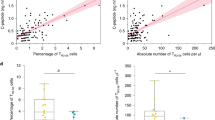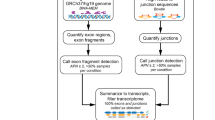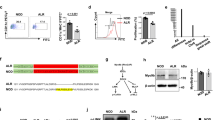Abstract
Type 1 diabetes (T1D) has a strong genetic component and the major locus lies in the HLA DQB1 region. We found earlier an increased apoptosis with decreased viability and function of the CD4+CD25+high T-cell subset (Treg) in human subjects with recent-onset T1D and in multiple autoantibody-positive, high at-risk individuals. Tregs normally inhibit or delay onset of T1D in animal models and increased Treg apoptosis could bring on or accelerate disease from effector T-cell-mediated destruction of insulin-producing beta cells. In this study, we test the hypothesis that HLA DQB1 genotypes are associated with increased CD4+CD25+high T-cell apoptosis. HLA DQ-based genetic risk status was significantly associated with CD4+CD25+high T-cell apoptosis, after adjustment for age, gender and phenotypic status (n=83, F=4.04 (d.f.=3), P=0.01). Unaffected, autoantibody-negative high risk HLA DQB1 control subjects showed increased CD4+CD25+high apoptosis levels compared with low risk HLA DQB1 control subjects (n=26, P=0.002), confirming that the association precedes disease. The association of specific HLA DQB1 genotypes with Treg apoptosis was also tested, showing significance for HLA DQB1*0302, DQB1*0201 and HLA DQB1*0602 alleles. Our study shows an association of HLA DQB1 genotypes with CD4+CD25+high T-cell apoptosis, which implicates CD4+CD25+high T-cell apoptosis as a new intermediate trait for T1D.
This is a preview of subscription content, access via your institution
Access options
Subscribe to this journal
Receive 6 digital issues and online access to articles
$119.00 per year
only $19.83 per issue
Buy this article
- Purchase on Springer Link
- Instant access to full article PDF
Prices may be subject to local taxes which are calculated during checkout




Similar content being viewed by others
References
Ounissi-Benkalha H, Polychronakos C . The molecular genetics of type 1 diabetes: new genes and emerging mechanisms. Trends Mol Med 2008; 14: 268–275.
Pirot P, Cardozo AK, Eizirik DL . Mediators and mechanisms of pancreatic beta-cell death in type 1 diabetes. Arq Bras Endocrinol Metabol 2008; 52: 156–165.
Ellerman KE, Like AA . Islet cell membrane antigens activate diabetogenic CD4+ T-cells in the BB/Wor rat. Diabetes 1999; 48: 975–982.
Whalen BJ, Greiner DL, Mordes JP, Rossini AA . Adoptive transfer of autoimmune diabetes mellitus to athymic rats: synergy of CD4+ and CD8+ T cells and prevention by RT6+ T cells. J Autoimmun 1994; 7: 819–831.
Edouard P, Hiserodt JC, Plamondon C, Poussier P . CD8+ T-cells are required for adoptive transfer of the BB rat diabetic syndrome. Diabetes 1993; 42: 390–397.
Severe S, Gauvrit A, Vu AT, Bach JM . CD8+ T lymphocytes specific for glutamic acid decarboxylase 90-98 epitope mediate diabetes in NOD SCID mouse. Mol Immunol 2007; 44: 2950–2960.
Irie J, Wu Y, Kachapati K, Mittler RS, Ridgway WM . Modulating protective and pathogenic CD4+ subsets via CD137 in type 1 diabetes. Diabetes 2007; 56: 186–196.
Serreze DV, Holl TM, Marron MP, Graser RT, Johnson EA, Choisy-Rossi C et al. MHC class II molecules play a role in the selection of autoreactive class I-restricted CD8 T cells that are essential contributors to type 1 diabetes development in nonobese diabetic mice. J Immunol 2004; 172: 871–879.
Chen Z, Herman AE, Matos M, Mathis D, Benoist C . Where CD4+CD25+ T reg cells impinge on autoimmune diabetes. J Exp Med 2005; 202: 1387–1397.
Durinovic-Bello I, Steinle A, Ziegler AG, Schendel DJ . HLA-DQ-restricted, islet-specific T-cell clones of a type I diabetic patient. T-cell receptor sequence similarities to insulitis-inducing T-cells of nonobese diabetic mice. Diabetes 1994; 43: 1318–1325.
Ott PA, Herzog BA, Quast S, Hofstetter HH, Boehm BO, Tary-Lehmann M et al. Islet-cell antigen-reactive T cells show different expansion rates and Th1/Th2 differentiation in type 1 diabetic patients and healthy controls. Clin Immunol 2005; 115: 102–114.
Peakman M, Wen L, McNab GL, Watkins PJ, Tan KC, Vergani D . T cell clones generated from patients with type 1 diabetes using interleukin-2 proliferate to human islet antigens. Autoimmunity 1994; 17: 31–39.
Zucchelli S, Holler P, Yamagata T, Roy M, Benoist C, Mathis D . Defective central tolerance induction in NOD mice: genomics and genetics. Immunity 2005; 22: 385–396.
Todd JA, Bell JI, McDevitt HO . HLA-DQ beta gene contributes to susceptibility and resistance to insulin-dependent diabetes mellitus. Nature 1987; 329: 599–604.
McDevitt HO . The role of MHC class II molecules in susceptibility and resistance to autoimmunity. Curr Opin Immunol 1998; 10: 677–681.
Baecher-Allan C, Wolf E, Hafler DA . MHC class II expression identifies functionally distinct human regulatory T cells. J Immunol 2006; 176: 4622–4631.
Ilonen J, Sjoroos M, Knip M, Veijola R, Simell O, Akerblom HK et al. Estimation of genetic risk for type 1 diabetes. Am J Med Genet 2002; 115: 30–36.
Brusko TM, Wasserfall CH, Clare-Salzler MJ, Schatz DA, Atkinson MA . Functional defects and the influence of age on the frequency of CD4+ CD25+ T-cells in type 1 diabetes. Diabetes 2005; 54: 1407–1414.
Glisic-Milosavljevic S, Waukau J, Jailwala P, Jana S, Khoo HJ, Albertz H et al. At-risk and recent-onset type 1 diabetic subjects have increased apoptosis in the CD4+CD25+ T-cell fraction. PLoS ONE 2007; 2: e146.
Lindley S, Dayan CM, Bishop A, Roep BO, Peakman M, Tree TI . Defective suppressor function in CD4(+)CD25(+) T-cells from patients with type 1 diabetes. Diabetes 2005; 54: 92–99.
Singer J, Willett JB . Applied Longitudinal Data Analysis: Modeling Change and Event Occurrence. University Press: Oxford, 2003, pp 45–72.
Peng HJM, Zhong H, Brantley M, Pyne M, Hagopian W . Maximizing performance of HLA DR-DQ screening to predict T1D in the pediatric population. Diabetes 2006; 55: 43A.
Klitz W, Maiers M, Spellman S, Baxter-Lowe LA, Schmeckpeper B, Williams TM et al. New HLA haplotype frequency reference standards: high-resolution and large sample typing of HLA DR-DQ haplotypes in a sample of European Americans. Tissue Antigens 2003; 62: 296–307.
Baecher-Allan CM, Hafler DA . Functional analysis of highly defined, FACS-isolated populations of human regulatory CD4+CD25+ T cells. Clin Immunol 2005; 117: 192 discussion 193.
Khoury SJ, Guttmann CR, Orav EJ, Kikinis R, Jolesz FA, Weiner HL . Changes in activated T cells in the blood correlate with disease activity in multiple sclerosis. Arch Neurol 2000; 57: 1183–1189.
Bieganowska KD, Ausubel LJ, Modabber Y, Slovik E, Messersmith W, Hafler DA . Direct ex vivo analysis of activated, Fas-sensitive autoreactive T cells in human autoimmune disease. J Exp Med 1997; 185: 1585–1594.
Kent SC, Chen Y, Bregoli L, Clemmings SM, Kenyon NS, Ricordi C et al. Expanded T cells from pancreatic lymph nodes of type 1 diabetic subjects recognize an insulin epitope. Nature 2005; 435: 224–228.
Glisic-Milosavljevic S, Wang T, Koppen M, Kramer J, Ehlenbach S, Waukau J et al. Dynamic changes in CD4+ CD25+(high) T cell apoptosis after the diagnosis of type 1 diabetes. Clin Exp Immunol 2007; 150: 75–82.
Nepom GT, Kwok WW . Molecular basis for HLA-DQ associations with IDDM. Diabetes 1998; 47: 1177–1184.
Scola L, Lio D, Candore G, Forte GI, Crivello A, Colonna-Romano G et al. Analysis of HLA-DRB1, DQA1, DQB1 haplotypes in Sardinian centenarians. Exp Gerontol 2008; 43: 114–118.
Spoletini M, Petrone A, Zampetti S, Capizzi M, Zavarella S, Osborn J et al. Low-risk HLA genotype in Type 1 diabetes is associated with less destruction of pancreatic B-cells 12 months after diagnosis. Diabet Med 2007; 24: 1487–1490.
Zung A, Elizur M, Weintrob N, Bistritzer T, Hanukoglu A, Zadik Z et al. Type 1 diabetes in Jewish Ethiopian immigrants in Israel: HLA class II immunogenetics and contribution of new environment. Hum Immunol 2004; 65: 1463–1468.
Erlich H, Valdes AM, Noble J, Carlson JA, Varney M, Concannon P et al. HLA DR-DQ haplotypes and genotypes and type 1 diabetes risk: analysis of the type 1 diabetes genetics consortium families. Diabetes 2008; 57: 1084–1092.
Thomson G, Valdes AM, Noble JA, Kockum I, Grote MN, Najman J et al. Relative predispositional effects of HLA class II DRB1-DQB1 haplotypes and genotypes on type 1 diabetes: a meta-analysis. Tissue Antigens 2007; 70: 110–127.
Michalek J, Vrabelova Z, Hrotekova Z, Kyr M, Pejchlova M, Kolouskova S et al. Immune regulatory T cells in siblings of children suffering from type 1 diabetes mellitus. Scand J Immunol 2006; 64: 531–535.
Buzzetti R, Galgani A, Petrone A, Del Buono ML, Erlich HA, Bugawan TL et al. Genetic prediction of type 1 diabetes in a population with low frequency of HLA risk genotypes and low incidence of the disease (the DIABFIN study). Diabetes Metab Res Rev 2004; 20: 137–143.
Perfetto SP, Chattopadhyay PK, Roederer M . Seventeen-colour flow cytometry: unravelling the immune system. Nat Rev Immunol 2004; 4: 648–655.
Baecher-Allan C, Viglietta V, Hafler DA . Inhibition of human CD4(+)CD25(+high) regulatory T cell function. J Immunol 2002; 169: 6210–6217.
Glisic-Milosavljevic S, Waukau J, Jana S, Jailwala P, Rovensky J, Ghosh S . Comparison of apoptosis and mortality measurements in peripheral blood mononuclear cells (PBMCs) using multiple methods. Cell Prolif 2005; 38: 301–311.
Acknowledgements
The authors thank Karen Zeqiri, Hope Albertz, Jeffrey Woodliff and Corbett Reinbold for technical support. This project was funded by the Children's Hospital of Wisconsin, Clinical Research Institute and General Clinical Research Center grant M01 RR00058 from the National Center for Research Resources, National Institutes of Health. The funding source did not have any role in study design, collection of data, analysis and interpretation of results. The authors declare no competing interests.
Author information
Authors and Affiliations
Corresponding author
Additional information
Supplementary Information accompanies the paper on Genes and Immunity website (http://www.nature.com/gene)
Supplementary information
Rights and permissions
About this article
Cite this article
Glisic, S., Klinker, M., Waukau, J. et al. Genetic association of HLA DQB1 with CD4+CD25+high T-cell apoptosis in type 1 diabetes. Genes Immun 10, 334–340 (2009). https://doi.org/10.1038/gene.2009.14
Received:
Accepted:
Published:
Issue Date:
DOI: https://doi.org/10.1038/gene.2009.14
Keywords
This article is cited by
-
Regulatory T cell dysfunction in type 1 diabetes: what’s broken and how can we fix it?
Diabetologia (2017)
-
Baicalein induces CD4+Foxp3+ T cells and enhances intestinal barrier function in a mouse model of food allergy
Scientific Reports (2016)
-
Baicalin, a natural compound, promotes regulatory T cell differentiation
BMC Complementary and Alternative Medicine (2012)
-
Evaluation of T regulatory cell apoptosis in children with newly recognized type 1 diabetes mellitus
European Journal of Medical Research (2010)



